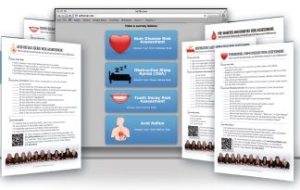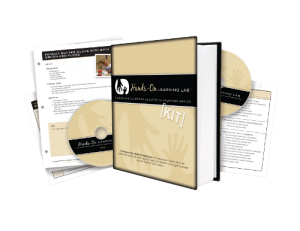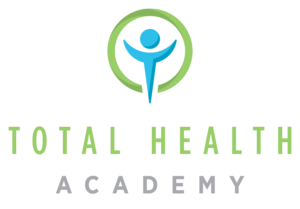Adult THA Package
Declining Health in America
The Dental Team’s Growing Role
Lifestyle Disease
Facilitating Health Change Behavior
Knowing what you “should” be doing and actually doing it are two different things. So, before we explore the what to health-pieces to change, this segment will help you with how to help people choose change. Shifting from education which signifies a one-way communication scheme to facilitation, which signifies two-way communication—a dialogue—is the only way to enact real change in health behavior. In this module you will learn the how to help convert knowledge into action. By learning dialogue skills that are based on curiosity, following another person’s lead, and shifting from certainty to open-to-outcome, you will become the gifted facilitator who can help your patients literally turn their lives around.
Oral-Systemic Health Overview
Shifting from ‘Diagnose and Treat’ to
’Predict and Pre-empt’ Disease
Elevating the Role of the
Hygienist and the
Hygiene Hand-Off
The New
Total Health
History Form
Since the beginning of time, the patient health history served primarily as a medical-legal catch-all. In dentistry it served mostly as a permission slip for patients to receive care. Finally, Total Health Academy offers you a revolutionary way to record a person’s health history! This form is organized in categories by disease/dysfunction. It asks the patient critical screening questions within each category in order to:
- Give the parent “Ah-ha” moments…. windows into the possible/probable cause of their child’s symptoms.
- Help the caregiver (RDH, RDA and dentist) identify signs and symptoms of systemic diseases/deformities/dysfunctions as well as oral manifestations of common diseases.
- Serves as a communication tool to bridge the gap between medicine and dentistry, helping you advocate for your patient, while creating co-referral relationships with medical professionals in your community.
Introducing SelfScreen.net
Facilitating Health Change Behavior
Asking the Right Questions
This module will teach you how to integrate your Self-Screen.net package into practice. To remind you, SelfScreen.net is a collection of seven different self-screening tools to help patients, dental team members and and medical teams bridge the gap between oral health and systemic health.
By helping patients learn the risk factors for the most commonly debilitating systemic and oral health threats, and identifying their personal risk levels we have an opportunity to foster health, create physician referral networks, and become total health advocates for our patients.
Remember, your THA investment includes all seven SelfScreen.net tools: Diabetes/Pre-Diabetes, Acid Reflux, Obstructive Sleep Apnea in adults, Sleep Disordered Breathing and OSA in children, Chronic Systemic Inflammation from Food Sensitivities, Periodontal Disease (for medical professionals to identify and refer to you) and Caries Disease (for medical professionals to identify and refer to you).
Each of these are customized for practice identification with ties to your website and phone. SelfScreen.net includes tear-off paper tablets for easy distribution to medical teams—plus a personalized landing page, accessible from any electronic device, which will link potential new patients directly to your practice’s website/contact info. This module will teach you how and when to implement the self-screen tools, identifying the risk factors for various diseases/conditions, and how to communicate with other medical professionals for referrals back and forth.
Addressing Obesity and
Coaching for Nutrition
Periodontal Disease
Etiology, Diagnosis and Treatment
Salivary Diagnostics
in Periodontal Disease
Genetic Predisposition and Bacteria Infection
Chronic Systemic Inflammation
Five Major Sources We Can Detect
Cardiovascular Disease Update
and Introduction
to the CVD
Links to Periodontal Disease
Tobacco Cessation and its Role
in Periodontal
Disease Treatment
Insulin Resistance and
Pre-Diabetes
Bi-Directional Effects of
Diabetes on
Periodontal Disease
Caries Disease
What We Know Now
HPV and Oral Cancer
Salivary Testing and its Implications
More on Nutrition
Balancing the pH of the body
Acid Reflux and Airway Reflux
Detection and Treatment Options
Learn the role nutrition plays in the development of acid reflux, how to identify the warning signs of acid reflux and how to help patients balance the pH of their esophagus, mouth and airway.Acid reflux affects as many as 60 percent of Americans a year and 30% on a weekly basis, according to Dr. Jamie Koufman, a leader in acid reflux treatment and author of Dropping Acid: The Reflux Diet Cookbook and Cure—and sales of prescribed and over-the-counter anti-reflux medications now exceed $13 billion per year. Reflux can be identified in the mouth by patterns of enamel erosion and if caught early can prevent such deadly complications as esophageal cancer, which has increased by about 500% since the 1970s. Learn how to use the customized self-screening tool for acid reflux, how to recognize risk factors, know when to refer for definitive diagnosis and treatment, and how to facilitate for diet change and weight loss.
Also, in this module learn how to identify the telltale “silent” signs of acid reflux, the role bio-individual nutrition plays, other tips for overcoming reflux, as well as the inherent dangers of long-term use of PPI medications.
Obstructive Sleep Apnea
in Adults
Screening, Diagnosis, Treatment Options
Depression
Learning to Recognize It, Talk About It and Facilitate Positive Outcomes
Food Sensitivities and Toxins
How to Counsel for Detection
Hypertension
When to Screen and How to Help
Pregnancy Complications
Related to Dental Disease
Joint Replacement Guidelines
and Indications
for Pre-Medication
Appropriate Antibiotic and
Opioid Prescribing
Poly-Pharmacology
Drug Interactions and Side Effects
One of the telltale signs of shifting from a health care model to a sick care model is the increasing number of medications listed (or not) on the patient’s health history. A-pill-for-an-ill has become a way of life, with television advertising (a U.S. phenomenon) predominantly focused on new and better medications for our lifestyle related illnesses. Of course, all these drugs have side effects of their own, not to mention interactional side effects when mixed with others. The most widespread patient complaint, caused by 400+ commonly taken medications is one that wreaks havoc with oral health and dental stability—xerostomia, or dry mouth. This module will teach you more about dry mouth but also more about how to identify other interactional side effects and communicate with medical teams as a generous act of patient advocacy.
Salivary Diagnostics and
Its Future in Total Health
Networking with the Medical
Community for Physician
Co-Referral Relationships
Community Outreach for Public
Health and for Creating
a Competitive Advantage
Marketing Development and
Club Membership
Opportunities for Total Health
This module begins with basic marketing education and the rationale behind choosing target market patient segment(s) and creating satisfaction among them. For your total health dental practice your target market includes health-seeking patients—those who regularly invest in optimal health and refer their health-seeking friends. You will also learn some proven strategies, including club membership(s), designed to convert your current target market patients into apostles of your practice, spreading the news among their friends, family and co-workers. And if you’re interested in advertising, learn to put your investment in front of your target population.
Includes
Customized SelfScreen.Net Pkg
and all support materials

Self-Screen.net
Your ability to assess risk factors for important oral-systemic diseases/conditions and effectively communicate with other medical professionals for co-referrals just got easier!
Self-Screen.net is a customized collection of seven screening tools to help your patients, team members and and supporting medical professionals identify oral signs and reported symptoms for critical metabolic and inflammatory diseases. The collection is designed to be used adjunctively with the THA modular health history form to uncover Diabetes/Pre-Diabetes, Acid Reflux, Obstructive Sleep Apnea in adults, Sleep Disordered Breathing and OSA in children, Chronic Systemic Inflammation from Food Sensitivities, Periodontal Disease (for medical professionals to identify and refer to you) and Caries Disease (for medical professionals to identify and refer to you). By helping patients self-identify their personal risk levels we have an opportunity to foster optimal health, create physician referral networks, deepen trust, increase case acceptance and become total health advocates for our patients.
Specific THA learning modules will help you integrate Self-Screen.net into your daily practice. The package includes a customized digital self-screen landing page that links to your website, and a starter pack of tear-off paper tablets (a dozen of each of the 7 screening tools) that are customized with your office identity.
Pediatric THA Package
The Pediatric
Total Health History
For most general practitioners, the pediatric health history has been insufficient or nonexistent. And now that infant oral health is our responsibility, we need to ask different questions. Finally, Total Health Academy offers you a refreshing approach to pediatric care, and to root cause analysis! This form is organized in categories by disease/dysfunction. It asks the parent critical screening questions about their child within a multitude of categories in order to:
- Give the parent “Ah-ha” moments…. windows into the possible/probable cause of their child’s symptoms
- Help the caregiver (RDH, RDA and dentist) identify signs and symptoms of systemic diseases/deformities/dysfunctions as well as oral manifestations of common diseases
- Serves as a communication tool to bridge the gap between medicine and dentistry, helping you advocate for your patient, while creating co-referral relationships with medical professionals in your community.
Infant Oral Health Exams
and Transmissibility of
Caries Infection
Self-Prophy for
Personal Skill Building
Hands-On Learning Lab
Shifting from Teach-n-Tell
to Total Engagement
Pediatric Nutrition
8 Food Rules
Pediatric Airway and
Sleep Disordered Breathing
Lip Ties and Tongue Ties
Diagnosis and Treatment
Most health professionals don’t recognize the importance of breast feeding for oral-facial and airway development. By releasing tethered tissues (lip-ties and tongue-ties) we can help infants create an efficient latch. The results are amazing! Not only can we strengthen mother/baby bonding, but we can influence health for the rest of their lives. Babies who are able to efficiently suck from the breast will strengthen their tongue, expand their palate, open nasal breathing and influence the maturation of their midface and the airway. Who would think that dentistry could play such a vital role in the health of human being? This module will teach you how to screen for and inspire you to treat tethered tissues, while fortifying your dental practice by increasing revenues and medical community referrals..
Oral-Systemic Health Overview
Shifting from ‘Diagnose and Treat’
to ‘Predict and Pre-empt’ Disease
.
Declining Health in America
The Dental Team’s Growing Role
Toggle Content goes here
Lifestyle Disease
Facilitating Health Change Behavior
All the education in the world won’t change a person’s behavior. Think about yourself.
Knowing what you “should” be doing and actually doing it are two different things. So, before we explore the “what” to health-pieces to change, this segment will help you with “how” to help people choose change. Shifting from education which signifies a one-way communication scheme to facilitation, which signifies two-way communication—a dialogue—is the only way to enact real change in health behavior. In this module you will learn the how to help convert knowledge into action. By learning dialogue skills that are based on curiosity, following another person’s lead, and shifting from certainty to open-to-outcome, you will become the gifted facilitator who can help your patients literally turn their lives around.
.
Includes
Hands-On Learning Lab™ Kit &
all support materials

The Hands-On Learning Lab™ Kit is your complete manual for this paradigm-busting approach to growing healthy children and a standout dental practice. The kit contains all the whys, what’s-needed, and how-to’s for the Self Prophy model and 60+ different science experiments that will revolutionize your children’s 6-month preventive visits. Establishing a Hands-On Learning Lab ™ approach will spotlight your Total Health Dental Practice to attract new patients who value their family’s health enough to invest in it. While you put kids in their own driver’s seat toward optimal health, you will win the gratitude of parents and become the positive talk of your town. Dig in and prepare to be WOWed!

SelfScreen.Net Package

Hands-On Learning Lab™ Kit
Each kit also available separately!
Please contact us for more information.
You can reach us Online or by phone at 616-502-7283.
